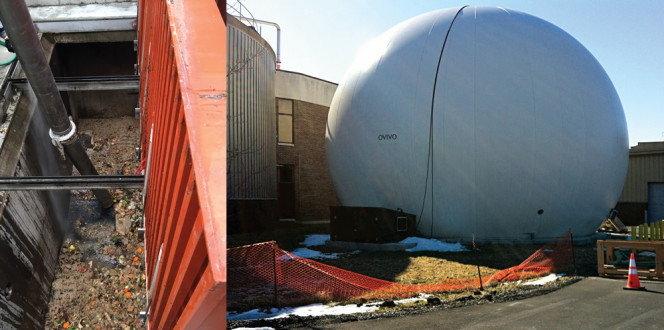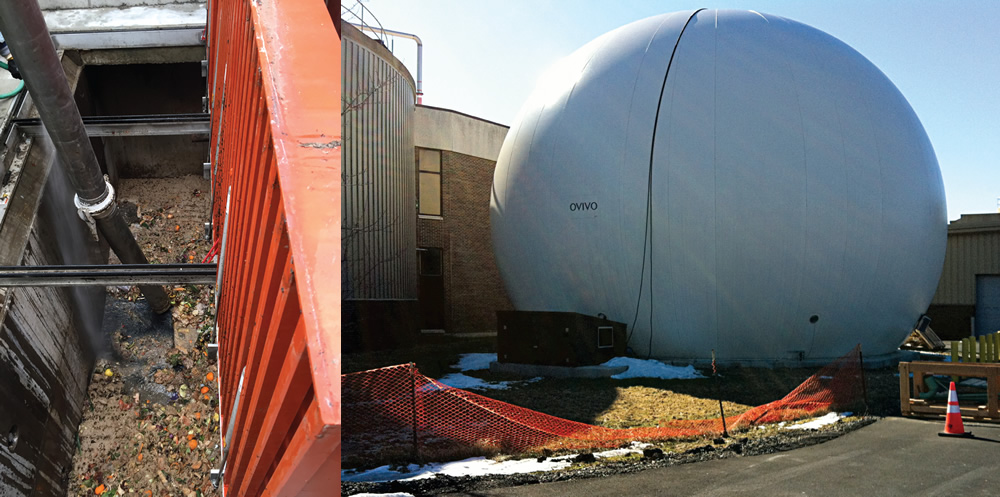Halfway towards net zero energy, this Ithaca, New York area wastewater treatment facility combines energy efficiency upgrades with an addition of food waste and other high strength organics to its anaerobic digesters.
Claire Siegrist
BioCycle May 2015
The Ithaca Area Wastewater Treatment Facility (IAWWTF) in Ithaca, New York has been working towards power positive operations, starting in the 1980s with installation of two 1.4 million gallon anaerobic digesters, and a cogeneration plant. Over the past five years, it has undergone multiple renovations to improve the energy efficiency of the wastewater treatment process, including a pilot test in 2014 of a new technology developed by ClearCove Systems that increases the amount of organic material removed from incoming wastewater through a gravity-fed screening process. The solids are diverted to the anaerobic digesters, reducing the amount of energy required for the aeration phase of wastewater treatment.

The ClearCove Enhanced Primary Treatment system was piloted at IAWWTF in 2014 (right). Organics and solids settle to the bottom of the tank, as illustrated in the samples at far right. Photo courtesy of A. Sue Weisler, RIT
Laying The Groundwork
The design capacity of the IAWWTF is 13.1 million gallons per day (MGD) on a monthly average. The average flow of sewage treated daily at the facility is approximately 6.5 MGD. Energy efficiency improvements have been underway since 2009 at the IAWWTF. A $9 million performance contract with Johnson Controls included upgrades to the aeration system in the secondary treatment train, as well as lighting and HVAC. The bulk of the energy reduction came from the new blowers and dissolved oxygen controls in the aeration system. By making this change, the energy requirement for aeration has been reduced from about 170 amps using two blowers to an average of 100 amps with one blower — a savings of approximately 25,000 kWh per month. Ovivo linear motion mixers (under 10 horsepower per digester) were installed in each digester, decreasing energy requirements for digestion.
The second component of IAWWTF’s progress toward power positive operations is increased production of biogas and better utilization of the biogas produced. The facility installed four C65 Capstone Microturbines with integrated heat exchangers that produce 260 kW of electric power and 1 million BTUs of hot water that is used to heat the digester tanks. Also installed were an Ovivo Ecomembrane gas storage membrane system, and a Unison biogas cleanup skid that removes siloxanes via a carbon filter before the biogas is combusted. These improvements allow the plant to use the biogas produced on site to generate an average of 120,000 kWh per month from about 3.5 million cubic feet of gas per month, providing over 50 percent of the plant’s energy needs. Additionally, operating costs have been cut in half or more.
The IAWWTF also built a $3 million receiving facility for food waste and other high strength organics delivered by tanker trucks directly to the digesters. The trucked residual receiving center is equipped with three underground 20,000-gallon storage tanks serviced by two JWC Honey Monsters that have a grinder and a one-quarter-inch perforated plate to remove grit and garbage out of incoming food waste streams. Addition of food waste and other high strength organics accounts for 40 percent of the IAWWTF’s biogas production (in-plant biosolids constitute the other 60 percent).
The last piece of the project is to work with Cornell Dining at Cornell University and the Ithaca community to collect pulped food waste. Currently, pulped food waste is sent to Cornell’s Farm Services Composting Facility; additional food waste from other campus and community eateries is sent to Cayuga Compost. An initial attempt was made by IAWWTF to accept Cornell University’s food waste, but the grinder at the treatment plant’s trucked residual receiving center was installed in such away that the food waste from Cornell Dining passed through unground. The IAWWTF is currently retrofitting the receiving facility to avoid that problem, and hopes to accept large loads from Cornell University in the near future. Dan Ramer, Chief Operator of the IAWWTF, also plans to work with Tompkins County Solid Waste to help collect additional high quality organics from the community.
The biogas produced is 68 percent methane and 32 percent carbon dioxide (CO2). The IAWWTF is looking into conditioning the gas to a higher methane content in order to compress it into a vehicle fuel to be sold for $2 a diesel gallon equivalent.

Construction of a $3 million receiving facility for food waste and other high strength organics was completed in January (left). Biogas from the AD tanks is directed to a gas storage membrane system (right).
Primary Treatment Pilot
The IAWWTF utilizes a gravity system for primary treatment that removes about 20 to 30 percent of the organic matter from incoming wastewater. The remaining 70 to 80 percent of organics in the wastewater are treated in aeration basins — consuming a large amount of energy. While the improvements made at IAWWTF increased the amount of energy generated on site and decreased the energy required to run the facility, the plant is still about 40 to 50 percent away from being net zero. A pilot project conducted by ClearCove Systems from March until September 2014 showed promise in moving IAWWTF closer to its net positive goal. The pilot was partially funded by a research grant from the New York State Energy Research and Development Authority (NYSERDA).
ClearCove’s Enhanced Primary Treatment (EPT) system uses a gravity-driven screening technology to remove more organic matter from the wastewater before it undergoes secondary treatment or aeration. More organic matter taken out of the wastewater during primary treatment reduces the plant’s energy usage and increases biogas generation, according to the company. “The wastewater flows into the EPT unit in the primary treatment stage,” explains Alex Wright of ClearCove. “The organics and solids settle to the bottom of the tank. The wastewater at the top of the tank is filtered with a 50-micron screen and moves on to secondary treatment. The solids captured in the EPT unit are sent to our proprietary Sludge Classifying Press (SCP) screening technology, which removes the nondigestible material such as grit, hair and fibers from the sludge while at the same time shearing and squeezing the solids to release encased organics. The nondigestible material removed from the sludge is disposed while the ‘cleaner’, conditioned sludge is anaerobically digested.”
The study at IAWWTF found that the EPT system reduced energy consumption during aeration by 62 percent and increased methane gas production by up to 500 percent over the current process where a majority of the organics remains in traditional settling tanks. “We see the opportunity in ClearCove’s technology to further our net positive energy potential,” says Ramer.
The IAWWTF commenced an engineering study in April 2015 to evaluate how the technology fits into the facility on a permanent basis. It will compare it with one other filter-based enhanced primary technology. It is important for the IAWWTF to do these studies so the projects are aligned with the Ten State Standards for wastewater treatment, a set of policies for the design, review and approval of plans for wastewater treatment facilities. There are currently no standards for what ClearCove is doing, however the company and several state agencies are working on developing standards. IAWWTF, which is owned by three different municipalities, will need grant funds to proceed with the primary treatment upgrade.
The energy efficiency and energy improvement steps taken at the IAWWTF can serve as a model for other wastewater treatment plants in New York State. Of the 600 WWTPs in the state, 117 have digesters. Of the 117, 72 facilities receive over one million gallons of flow per day. Of these 72, only 16 are producing energy.
Claire Siegrist is STARS Coordinator at Cornell University’s Campus Sustainability Office and a Contributing Writer to BioCycle.













